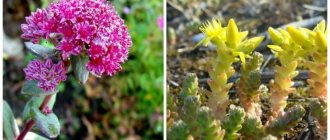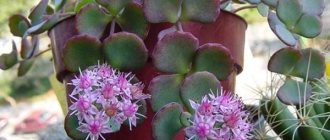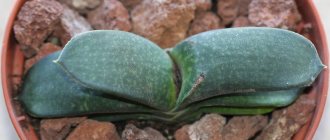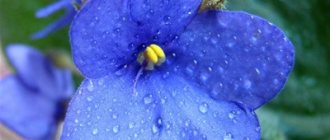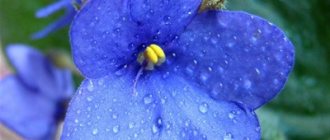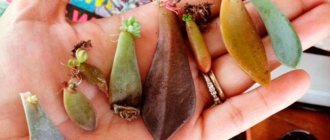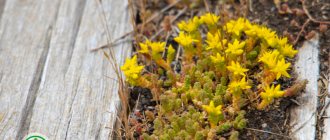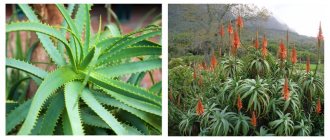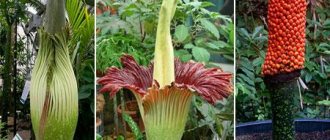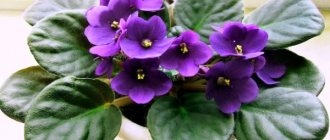Sedum is a flower that seems to have care, but it doesn’t seem to exist. It’s worth looking after the plant: remove dry shoots and weeds, water during drought, and even feed it a couple of times a season, but the main rule is not to overdo it!
Sedums are the most numerous genus of the Crassulaceae family, numbering about 600 species. This genus includes annual, biennial and perennial succulent plants, which are divided into shrubby, thicket and creeping subspecies. Many of them are evergreen and remain decorative even in the harsh winters of the middle zone.
Succulents of the genus Sedum are found on all continents except Antarctica and Australia. There are more than 50 European species alone, and from 60 to 100 varieties are grown in Russia.
- Garden sedums - overview of types and varieties with descriptions
Creaking grass, hare cabbage and hernia grass - do you have such “residents” on your site?
Gardeners highly value these plants with fleshy leaves and stems for their unpretentiousness, gentle disposition and ability to decorate even dry and rocky areas unsuitable for other crops. At the same time, having a modest character, sedums are distinguished by abundant and long flowering, as well as the original color of the foliage, which in many varieties changes color during different periods of the growing season or depending on the weather.
Most sedums growing in European regions, as well as some species of eastern origin, winter well in the middle zone, because... able to tolerate frosts down to –30°C. It is these sedums that summer residents most often choose for alpine hills and rockeries, border plantings and mixborders. More heat-loving species and varieties are usually grown in containers and transferred indoors during the cold period.
Sedums are an excellent option for creating recently popular low-maintenance gardens, since they do not require special attention and can survive even a long drought without loss.
Description of succulents of the genus Sedum and its features
Representatives of the genus Sedum were first officially described by Carl Linnaeus in 1753. There he introduced 15 species. Gradually, other plants were included in the Sedum genus, which led to their number exceeding 600 species. Scientists later divided Sedum into several separate genera, and even then Sedum occupies a third of the total number of species in the Crassulaceae family, although it has been reduced to about 420 species.
The degree of morphological diversity of Sedum is so great that scientists are still arguing regarding their taxonomy and cannot structure representatives of the genus Sedum into tribes and clades. There is even such a term as the “Sedum problem”, which emphasizes this situation in the taxonomic hierarchy of the Sedums.
The scientific name of the genus Sedum comes from the Latin. sedare - to pacify (the fleshy leaves of some species have analgesic properties). The common name Sedum comes from the Ukrainian Ochistok , due to the plant's use as a medicinal and cleansing agent.
Succulents of the genus Sedum can be found on all continents except Australia and Antarctica. For example, there are currently about 55 European species.
Description of plants
The genus Sedum includes annual, biennial and perennial creeping herbs, subshrubs and shrubs. They are characterized by fleshy leaves and stems. These are very hardy crops that grow in mountains, deserts and grasslands. Sedum even grows on sand dunes in coastal areas.
Conventionally, Sedums are divided into two groups - ground cover and tall crops.
Dimensions
Plant sizes vary significantly from species to species. The low-growing Sedum can spread up to a meter wide, but only grows a few centimeters tall. Vertically growing varieties can grow up to a meter in height and approximately 50 cm in circumference.
Leaves
Some types of succulent have hairy leaves, while others have shiny and waxy leaves. In most varieties, the leaves grow in clusters around stems or shoots. they vary greatly in shape and size depending on the species - from bean-shaped to spatulate with rosette forms.
Foliage color can range from light green to red and purple. Some plants have solid green foliage, while others have variegated foliage. Some change colors depending on the time of year or when under stress.
Bloom
Most species of Sedum have star-shaped, five-petaled flowers. The flowering time of succulents lasts from early spring or early summer until mid-autumn, depending on the variety.
The color of the petals varies from white to intense purple. The flowers are generally lightly scented and quite attractive to butterflies, bees and other pollinators.
Other features of Sedums
Most sedum flowers and leaves are edible and are often added to smoothies, soups and green salads for a slightly sour taste. However, Sedum acre is highly toxic because it is high in alkaloids and is therefore not edible. Also worth mentioning is Sedum rubrotinctum. Its leaves are poisonous and the juice can cause skin irritation.
Some species are medicinal plants. We will describe their beneficial properties below. You can learn more about these unique succulent crops in this video.
Popular varieties
Each variety of sedum has its own twist and is in demand among gardeners. However, there are varieties that have been popular for more than 5 years.
Sedum Kamchatka
A loose bush consisting of erect shoots 30-35 cm high. The length of the dark green elongated leaves is 4-5 cm. The edges at the base of the plate are smooth, and on the opposite - jagged. Yellow flowers up to 2 cm in diameter form dense inflorescences. The size of one umbrella is 11-13 cm. It enters the flowering phase in June and emerges after 2-3 weeks.
Sedum caramel Kamchatka
A perennial plant with vertical stems 20 cm high. The ellipsoid leaves have a blunt edge near the petiole and a toothed edge at the apex. Small flowers are orange-yellow. Corymbose inflorescences form in June and decorate the plants for 25-30 days.
Sedum purple carpet
A perennial herbaceous plant, which was discovered by the German botanist M. Bieberstein in the 19th century. The succulent is a compact bush 15-20 cm high and 40-50 cm in diameter. Densely leafy stems spread along the ground. Bright green oblong leaves are arranged in two rows.
The length of the plate is 5-6 cm, width - 3-4 cm. The flowers are red with pointed petals. Purple sedum blooms for 1.5-2 months, starting in the first half of summer. Succulent Sedum purpurea is grown from seeds according to the same principle as all succulents.
Sedum Eversa
Compact perennial shrub. By the beginning of autumn, the red-brown shoots become woody. The round, small leaves are bluish-gray and thick. Flowers, painted pink, are collected in inflorescences. The flowering period begins in July and lasts about two months. In autumn the plant sheds its leaves.
Sedum is beautiful
Perennial with creeping stems. The leaf blades are thick, turgorous, and bluish. Prefers to grow in soil made from leaf and turf soil, sand (1:1:2). Grow in low pots.
How to grow sedum at home
Of the variety of these succulents, almost all varieties can be grown in pots. But not all plants of this genus are frost-resistant and will not survive after wintering. It is advisable to keep such species indoors. Planting and caring for domestic Sedums is quite simple. It is worth paying attention to several nuances, which we will describe below.
What soil should be used for sedum in pots
When growing a flower indoors, it is important to use well-drained soil. Leaving the plant in fertile soil will cause the roots to rot, which may cause it to die. Sedum will grow in sandy, rocky or poor soil. It is important that the soil you purchase or mix drains well. The soil should have a neutral or slightly alkaline pH. The optimal composition of the soil mixture is soil for indoor plants, coarse sand (can be replaced with fine stone chips) and perlite in equal proportions.
Potty requirements
Choose a container with drainage holes. It is important to choose an appropriately sized pot or planter that has a few centimeters of extra space on the sides.
It is better to give preference to clay or ceramic pots. Both of these materials are porous, which allows water to drain away. For larger containers, plastic pots are better because they are lighter and easier to move.
Information on caring for succulents
Common diseases and pests of cacti and succulents
What, how and when to fertilize succulents - expert advice
How to water succulents: what gardeners advise
Planting sedum in a pot
Indoor sedum can be planted at any time of the year. There is nothing complicated in the planting process:
- Place a layer of drainage on the bottom of the container - expanded clay, small crushed stone or fragments of broken brick will do;
- Fill the container halfway with soil mixture;
- we lay the seedling or adult plant, straightening the roots;
- Finally fill the pot with soil and lightly compact it;
- water the soil well.
Where to place a flower pot
Like other succulents, Sedum loves sunlight. Place it near a window facing east, south or west. The flower will need at least 6 hours of sun per day. In the summer, it is advisable to take the pot with the succulent outside. Find a place near the house where the flower will be exposed to sunlight for half of the day.
During hot periods, it is advisable to slightly shade the Sedum so that the leaves do not get burned.
Priming
Sedum is used to growing in poor, nutrient-poor soil, so it does not accept nutritious or moist soil. The soil for the sedum should be loose enough so that air and moisture reach the root system in full.
Sedums can be very diverse
To create favorable growing conditions, it is necessary to choose the right soil mixture correctly. Ready-made soil can be purchased at a flower shop. You can make soil for succulents yourself by mixing sand, humus, and compost soil in equal portions. You can also add clay and wood ash. When planting or replanting, it is important to remember the drainage layer, which can be gravel or small stones.
Caring for Sedum indoors
A little extra care will have a beneficial effect on your houseplant.
How to water sedums in a pot
A minimum of water is the optimal solution. It is much easier to revive a dried out succulent than to try to treat a rotten plant due to waterlogging. At first, check the soil every few days for moisture. Water Sedum only when the soil is dry. Give it enough moisture until the soil is saturated with water. It is advisable to drain the excess water completely.
It is optimal to maintain the following watering frequency:
- in spring and summer – once a week (more often in hot weather);
- in autumn, reduce watering to once every 2 weeks;
- In winter, water once every 3-4 weeks.
If you place the pot outdoors and expose the Sedum to rain, make sure that excess moisture drains easily from the container.
Fertilizer for Sedum in a pot
When you first plant a flower, it is recommended to mix a slow-release granular fertilizer into the soil. In this case, no additional feeding is needed throughout the growing season. If you don’t have such fertilizer on hand, you can use liquid preparations. But it is advisable to dilute them half as much as indicated on the package. Too much fertilizer can make the plant grow too long. Try to use fertilizer with a minimum amount of nitrogen. In autumn and winter, stop feeding Sedum.
Replanting a succulent
Some varieties, especially groundcover varieties, grow quite quickly, outgrowing their pot. The time has come to think about transplanting Sedums. You need to get a pot one or even two sizes larger. You may even have to divide your plant into several parts for further propagation. For a new container, use the soil mixture described above. When repotting, inspect the succulent's roots for rot or disease. Remove dried roots. After transplanting, water the soil well.
Botanical description of succulent with photo
Sedum has the following botanical characteristics:
- leaves – whole, fleshy, alternate or sessile;
- flowers are bisexual, actinomorphic, star-shaped, collected in corymbose, umbellate or racemose inflorescences, characterized by sufficient density;
- rhizome – shortened, with numerous twisted tuberous lateral roots;
- stems are strong, evenly leafy, curved at the base;
- corolla - consists of 5 free petals, approximately 3 times longer than the sepals;
- the fruit is a red or pink multileaf with numerous seeds about 1 mm long.
The height of the plant ranges from 20 to 60 cm.
Planting and growing sedum in the garden
Unlike most varieties that grow in desert conditions and cannot tolerate cold, European species of Sedum tolerate frost well and thrive in our climatic conditions. Such succulents are worth and should be grown in the garden.
Oh, their decorative and medicinal properties are known to many gardeners, which is why these plants are very popular. The conditions for growing garden crops are slightly different from home flowers. We will describe them in detail.
Where is the best place to plant sedum in the garden?
As mentioned above, Sedums are sun-loving crops, and to grow they need a lighted area, which can be slightly shaded. The amount of time needed to illuminate garden plants is at least 6 hours.
Ground cover varieties can tolerate lower light conditions and are good for planting in shadier areas. Tall flowers are more demanding of light.
Succulents that do not receive enough light will stretch out, exposing the stems between the leaves. They will also reach or lean toward the light source.
In what soil is it better to plant garden sedums?
The succulent grows well in poor, sandy soils with good drainage.
It is very susceptible to root rot if grown in soil where moisture will stagnate. Excessively rich nutrient soil can encourage long plants to develop, which can cause the erect stems to become quite heavy during flowering and may bend or break.
The best time to plant sedum in open ground
The optimal period for planting succulent plants in open ground is the spring months. You need to choose a time when the danger of frost has passed, but the summer heat has not yet arrived.
How to plant Sedum
Make sure the soil where you plant is light and well-drained. It may need to be mixed with organic matter (compost), coarse sand or fine gravel to create a light, well-drained soil mixture.
Seedlings can be purchased at a garden center or grown yourself; below we will describe how to do this. The next steps are quite simple:
- Dig a hole twice the size of your succulents' root ball. At the bottom of the hole it is worth laying a drainage layer of expanded clay or fine gravel;
- add a little prepared soil mixture on top and lay the plants, first straightening the roots;
- fill the voids with the same soil mixture and compact it. When planting tall varieties, make sure that the stems are not in the ground, as they will begin to rot;
- Water the planting site well.
Trimming
To give the plant an ennobled appearance, you need to periodically trim the flower. Some gardeners wonder whether they need to prune sedum for the winter. Yes, the flower should be pruned after it has finished blooming. When pruning, you need to remove old flower stalks, dried or diseased parts of the perennial.
Some gardeners recommend trimming the top of the succulent for more luxuriant flowering. A beautifully trimmed bush will look attractive and neat.
Important! Some types of sedum are poisonous (acidic sedum and Morgana sedum). Gardening work with poisonous specimens should be done with gardening gloves so that the corrosive juice of the perennial does not get on the skin of your hands.
Further care for garden sedums
These succulents are not picky and should take root and grow easily. Pay attention to several nuances.
Watering
Sedums are drought tolerant and do need some water to survive, especially during the spring and summer growing season. Established flowers practically do not require additional watering; natural precipitation is enough for them.
During periods of prolonged drought and high temperatures, take care of watering (once a week). Moisten the soil well and let it dry.
Avoid getting leaves, stems and flowers wet.
Fertilizer
If organic matter was added to the soil during planting, there is no need to additionally feed your flowers. Repotting into fresh soil every few years or so will keep the Sedums well nourished. If you have plants that have been in the same soil for years, you can add a little complete fertilizer in the spring.
Wintering Sedum
Many varieties of garden succulents are quite hardy. Some varieties can withstand temperatures down to -30 °C.
If you do not dig up the flowers and transfer them to a cool room for the winter, you should cover them with spruce branches, soil or dry grass.
Be sure to find out about the frost resistance of the variety of your succulents and decide for yourself whether to leave them in the soil for the winter or move them indoors.
Pruning garden plants
Groundcover Sedums can grow strongly, forming a small mat. On the one hand, this adds decorativeness to your site, but on the other hand, they can affect neighboring plants. By separating them, you can control the size and also replant them in another place. This procedure can be performed throughout the entire growing season.
The stems of tall-growing Sedums die off during the winter. Many gardeners prefer to leave them in the flower garden - they are attractive in winter. However, in the spring, do not forget to prune by removing dried stems.
Photo of Morgana sedum in a hanging flowerpot
Creeping succulent species are often grown in hanging baskets, where they grow well. By cutting stems that are too long, you can control the shape of the plant. Also during the growing season, inspect your flowers for dead or damaged stems that need to be removed.
Bloom
A healthy plant can bloom annually. In the photo, the sedum flowers pleasantly surprise with their beauty. Typically, the flowering time of succulents is long: it begins in late spring or early summer. Some varieties begin to bloom in August. Flowering can continue until September or until the first frost.
Blooming sedum is loved by bees, who are attracted by the fragrant and sweet nectar of the perennial.
The color of the inflorescences depends on the plant variety:
- Common sedum and purple sedum bloom in small pink or lilac inflorescences.
Blooming sedum - Acrid sedum is lemon-colored and belongs to the ground cover sedums.
Sedum caustic flowering - White sedum confirms its name with snow-white flowers.
White sedum blooming
Diseases and pests Sedum
Although these succulents are somewhat resistant to various diseases and pests, it is important to check your flowers regularly to catch common ailments early.
Root rot
This disease is caused by bacteria that grow in moist soil. They damage the roots of the plant, and over time the plant stops absorbing water. This dehydration can kill your plant pretty soon.
The rot spreads from the roots, and often the first thing gardeners notice is black, soft stems or falling leaves that turn brown and translucent. If root rot is detected early enough, you can cut off the damaged roots and plant the Sedum in fresh soil. Most often you will have to cut the stem above the point where the rot has appeared. Be sure to sterilize cutting tools before and after use. After making the cut, you can allow the wound to heal and heal over the course of a week. Then stick it into soil or water to root the stem. Place the new plant in well-drained soil and water only when the soil is completely dry. This will prevent root rot from reoccurring.
Mealybugs
These are white, furry insects that live at the base of the plant's leaves. Once in these shelters, they can be difficult to spot. You may notice their honeydew, a sticky substance on the undersides of leaves, before you notice the insects themselves.
If there are a lot of ants in your area, this is another potential sign of mealybugs. They are closely related because ants breed mealybugs to grow honeydew and can actually transfer them to your succulents.
Remove mealybugs with a home remedy or chemical of your choice. Before using pesticides, read the rules for using the products and make sure they will not harm pets or children who may come into contact with your plants.
Aphids
Succulents, especially those grown outdoors, are susceptible to aphid infestation. These pests are very similar to mealybugs, as they are also small insects that produce honeydew. You can also use many remedies to get rid of them.
Spider mite
These pests are so tiny that we often don't notice them. This can be a problem as the infestation may get out of control before you realize that the Sedum is infested. These pests also leave behind a white webbing that can sometimes be seen before you notice the insects themselves. To treat spider mites, try homemade solutions or any pesticide of your choice.
Succulent Information
Sedum clubform
Features of the Far Eastern succulent Kamchatka sedum
Sedum Matrona: rules for planting and growing Sedum
Fertilizers
Sedum grows in low-nutrient soil, so it does not need frequent fertilizers. An increased amount of fertilizing can harm sedum, causing root rot and fungal diseases. You need to feed the succulent no more than two or three times a year. The first feeding should be done in April-May before the perennial blooms. A second feeding is needed in the fall.
It is undesirable to use nitrogen-containing fertilizers as fertilizer, as they can provoke the development of certain diseases. It is also impossible to fertilize perennials with fresh cow manure. A top dressing containing potassium and phosphorus would be ideal.
Reproduction Sedum
These succulents are very easy to propagate in several ways, two of which we will describe in more detail.
Propagation by leaf cuttings
The leaves tend to come off very easily and may fall off if touched. By leaving them in the soil, new plants will grow from them over time.
If you want to grow Sedum more specifically, follow these instructions:
- choose a healthy leaf, preferably tear it off the stem yourself;
- make sure that there are no parts left on the plant;
- Place the leaf next to the mother plant and water it as usual;
- as soon as the root system is formed, the young shoots can be transplanted to a new place or pot.
- Alternatively, you can place the leaf cuttings in a container, cover it with cling film and keep them there until the young shoots sprout.
Be sure to remove the lid when the succulents begin to grow to ensure adequate air flow. You will also need to gradually stop misting your plants as they grow because moisture on the leaves will damage fully grown succulents.
Propagation of Sedum by stem cuttings
This method involves doing the following:
- Sterilize cutting tools with medical alcohol;
- select a healthy stem of a recently watered succulent, preferably with at least a few leaves;
- make a clean cut on the sedum stem;
- allow the cut site to heal by putting the cutting aside for about a week in a dry place;
- plant the cutting in soil or a jar of water so that it can take root;
- Once the roots have formed, you can either plant the seedling near the mother plant and care for it as usual, or place it in a new location or pot.
Sedums are also often propagated by seeds for seedlings. We will talk about this method in more detail in our article. You can watch a video about other types of Sedum breeding.
